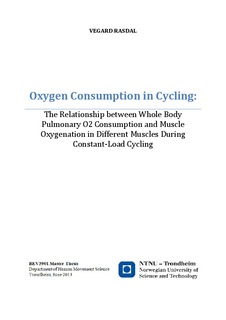| dc.description.abstract | Introduction: Oxygen consumption during prolonged cycling exercise has been extensively studied at different work rates and durations, but with the focus primarily on pulmonary oxygen consumption (pVO2). The purpose of this study was to use near-infrared spectroscopy (NIRS) to investigate the relationship between pVO2 and local oxygenation responses in six active leg muscles during prolonged constant-load cycling at different intensities.
Methods: 26 recreational male cyclists performed a constant-load high-intensity cycling test at 75% maximal aerobic power (MAP) for 30 min duration or until exhaustion. Of the 26 subjects, 14 performed a constant-load low-intensity cycling test for the same duration as well, at 50% of the work rate found to elicit blood lactate levels of 4 mmol∙l-1 during incremental exercise. Pulmonary gas exchange (pVO2, RER, VE), heart rate, and NIRS measurements of the muscles vastus lateralis (VL), vastus medialis (VM), biceps femoris (BF), gluteus maximus (GMax), gastrocnemius lateralis (GL), and tibialis anterior (TA) were obtained continuously through both tests, while blood lactate and RPE was measured at specific time intervals.
Results: Local oxygenation measurement for all the muscles collectively behaved in a similar manner as pVO2 at both intensities with an increase in O2 utilization only found in the initial phase, and additionally showed a surprisingly homogenous response. However, differences were found between the muscle groups with heterogeneity in regard to the amount of desaturation at low- and high-intensity.
Discussion: Although the local responses were similar to each other and that of pVO2, differences were found between the muscles with heterogeneity in regard to the amount of saturation. The distal muscles TA and GL showed less difference in saturation between low-intensity and high-intensity than the more proximal muscles (VL, VM, BF, and GMax). Also the BF and GMax muscles were found to behave different with a lack of TSI steady-state during high-intensity.
Conclusion: The use of NIRS might provide a noninvasive and direct way of measuring local oxygenation responses in muscles and provide an indication of the work contribution of various muscles during cycling exercise. Although local oxygenation responses across the muscles were in agreement with pVO2, difference in amount of saturation was found between muscle groups in the present study. Also peripheral differences were found between the subjects able to complete 30-min constant-load high-intensity cycling and those who did not.
Key words: Near-infrared spectroscopy, NIRS, cycling, constant-load, VO2, local oxygenation, tissue saturation, SmO2, muscle, muscle groups. | nb_NO |
